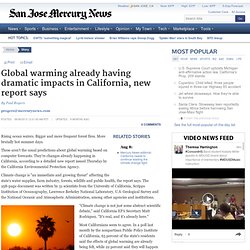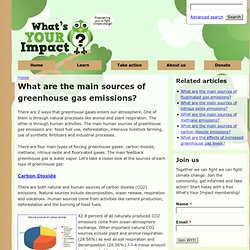

Global warming will impact the power grid. Climate Change Could Increase Armed Conflicts By 50 Percent Worldwide. A new study finds that across cultures, time and space, we consistently see more conflict as temperatures rise and rainfall becomes more erratic.

Image via Flickr user expertinfantry Climate change isn’t just affecting the natural world. Researchers have long understood that rising levels of greenhouse gas emissions will also have cascading ramifications on the dynamics of human society, whether by forcing refugees to flee from newly flood-prone areas or arid regions, by causing spikes in the prices of food crops, or by reducing the productivity of livelihoods based on fishing or grazing in certain regions. Recently, studies and journalistic investigations have focused on one particularly chilling potential social consequence of climate change: an increased frequency of armed conflicts around the world.
But what characteristics of these climate changes—heat and erratic rainfall—cause people or institutions to become violent? Carbon Inequality: Just One Percent Of U.S. Power Plants Produce 12 Percent Of U.S. Carbon Emissions. By Jeff Spross "Carbon Inequality: Just One Percent Of U.S.

Power Plants Produce 12 Percent Of U.S. Carbon Emissions" Georgia Power’s Plant Scherer CREDIT: Georgia Power Inequality isn’t just a matter of income: it plays out in carbon pollution as well. That one percent is actually 50 plants, all of them coal-fired. And the disproportionate contribution of the dirtiest plants to greenhouse gas emissions continues on down the scale: in 2011, half of all the power sector’s carbon emissions came from the 100 dirtiest plants (98 of which are coal-fired). Guy Carpenter Says ‘Global Warming’ a Reality - Citing IPCC Report. An article from Guy Carpenter states: “According to the IPCC Fourth Annual Assessment Report (AR4), the scientific consensus is that global warming is indeed an established scientific fact.

The evidence is undeniable, and includes: 1. Renewable energy is America's cheapest option, study finds. In a landscape marred by entrenched political and business interests that prefer the status quo, any prospect of shifting towards renewable energy sources can at times seem the purview of idealists.

But, according to a new study that aims for a more holistic count of energy costs, a switch to renewables by the U.S. wouldn't only be good for the planet -- it would actually make better sense financially. While on its face, producing electricity from fossil fuels might seem like the cheaper option, it fails to take into account the full picture. When public health, environmental, and social costs of tapping polluting energy resources are factored in, says the study, renewables like wind and solar would actually be cheaper. Halving global CO2 by 2050. A joint study by the Energy Futures Lab and the Grantham Institute for Climate Change at Imperial College London Download full report Download report annex Several analyses have suggested that limiting global warming to a 2 degrees Celsius rise above pre-industrial levels would require CO2 emissions of between 10 and 20 Giga tonnes (Gt) by 2050, depending on levels before and after this date.

In 2008, leaders at the Hokkaido Toyako G8 Summit in Japan agreed to support a goal of halving global CO2 emissions (then at levels of around 30Gt) by 2050, with a view to limiting global warming. Carbon Dioxide Emissions. Carbon dioxide (CO2) is the primary greenhouse gas emitted through human activities.

In 2011, CO2 accounted for about 84% of all U.S. greenhouse gas emissions from human activities. Carbon dioxide is naturally present in the atmosphere as part of the Earth's carbon cycle (the natural circulation of carbon among the atmosphere, oceans, soil, plants, and animals). Human activities are altering the carbon cycle—both by adding more CO2 to the atmosphere and by influencing the ability of natural sinks, like forests, to remove CO2 from the atmosphere. While CO2 emissions come from a variety of natural sources, human-related emissions are responsible for the increase that has occurred in the atmosphere since the industrial revolution. [1] Global warming already having dramatic impacts in California, new report says. Rising ocean waters.

Bigger and more frequent forest fires. More brutally hot summer days. These aren't the usual predictions about global warming based on computer forecasts. They're changes already happening in California, according to a detailed new report issued Thursday by the California Environmental Protection Agency. Climate change is "an immediate and growing threat" affecting the state's water supplies, farm industry, forests, wildlife and public health, the report says. Since 1895, annual average temperatures in California have increased about 1.5 degrees Fahrenheit and continue to rise, the report found.
"Climate change is not just some abstract scientific debate," said California EPA Secretary Matt Rodriquez. What produces greenhouse gas emissions? There are 2 ways that greenhouse gases enters our atmosphere.

One of them is through natural processes like animal and plant respiration. The other is through human activities. The main human sources of greenhouse gas emissions are: fossil fuel use, deforestation, intensive livestock farming, use of synthetic fertilizers and industrial processes. There are four main types of forcing greenhouse gases: carbon dioxide, methane, nitrous oxide and fluorinated gases. The main feedback greenhouse gas is water vapor. What are the main sources of carbon dioxide (CO2) emissions?
There are both natural and human sources of carbon dioxide emissions.

Natural sources include decomposition, ocean release and respiration. Human sources come from activities like cement production, deforestation as well as the burning of fossil fuels like coal, oil and natural gas. Due to human activities, the atmospheric concentration of carbon dioxide has been rising extensively since the Industrial Revolution and has now reached dangerous levels not seen in the last 3 million years.